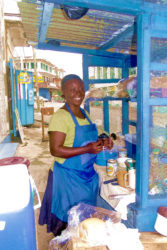There is a general acknowledgement here in Guyana and in other developing countries that street-vended foods play an important socioeconomic role in meeting food and nutritional requirements of coastal consumers at affordable prices to the lower and middle income people. Here in Guyana, street foods have also become inextricably linked to the popular ‘hang out’ night life that creates (particularly at weekends) an all-night market for street food vendors. Efforts by the Stabroek Business to secure reliable figures regarding the number of vendors offering cooked food at ‘the roadside’ so to speak were hampered by two factors. First, accurate counts are inhibited by a high percentage of non-registration (through the acquisition of Food Handler’s Certificates) with the municipal authorities; secondly, roadside food vendors tend to come and go with monotonous regularity. What we have been able to learn by engaging the Government Analyst-Food and Drugs Department (GA-FDD) is that roadside food vending continues to be popular in coastal Guyana and that the consumption of street-vended food continues to grow in popularity not only among working class Guyanese but amongst a sizeable portion of middle class Guyanese as well.
GA-FDD Director Marlan Cole told the Stabroek Business during a recent interview that the Department has been paying careful attention to the continually growing popularity of roadside food vending and the public health considerations associated therewith. Cole told this newspaper that whilst the possible health risks associated with unregulated street-vended foods are “plain for all to see” there has always been the tendency to balance that factor against the popularity of “an accessible, reasonably-priced meal on the one hand and the public health risks associated with an unregulated, out-of-control industry.”

